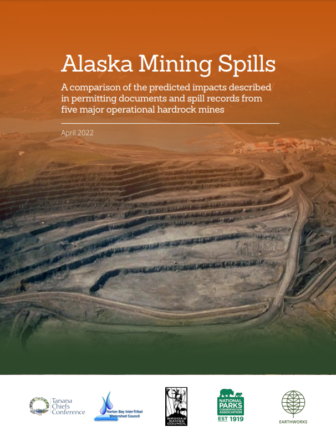Hardrock mines are large industrial facilities that generate and use large volumes of hazardous and toxic materials which present a significant environmental and public health risk if spilled into the environment. These spills can include processing chemicals (e.g., cyanide solution), ore concentrate (e.g., zinc and lead), fuels (e.g., diesel), mine tailings, blasting agents, water treatment chemicals, and other chemical reagents.
The permitting process is intended to provide decision-makers and the public with accurate information about the potential risks associated with a proposed mine, including any associated pipelines and access roads. Alaska has a long history of mining, and with it, a trove of mine permitting documents and environmental records. This report reviewed state and federal government records for the five major hardrock mining operations in Alaska (Pogo, Kensington, Greens Creek, Fort Knox/True North, and Red Dog), with the following objectives:
- Assess what spill risks are addressed in the permitting documents
- Use a consistent quantitative model for estimating the number of spills predicted and the probability of at least one trucking accident spill for all hazardous materials
- Compare actual spills to predicted numbers
- Offer model critiques
- Identify data gaps
- Synthesize the findings and make recommendations for the environmental review process
Additional appendices can be found here.
AUTHOR: Susan Lubetkin, PhD, has over 20 years of experience in environmental statistics and mathematical modeling, including estuarine food web modeling, whale growth, harmful algal blooms, and oil and gas spill risks. She earned a B.S. in biology at Harvey Mudd College and PhD at the University of Washington.
PREPARED FOR Brooks Range Council, Earthworks, National Parks Conservation Association, Norton Bay Intertribal Watershed Council, and Tanana Chiefs Conference.
Your Support Makes Our Work Possible
Earthworks helps families on the front lines of mining, drilling, and fracking. We use sound science to expose health, environmental, economic, social, and cultural impacts of mining and energy extraction. To support our efforts, please consider a tax-deductible donation today that will go toward our work reforming government policies, improving corporate practices, influencing investment decisions, and encouraging responsible materials sourcing and consumption.

